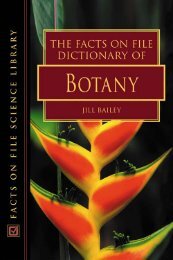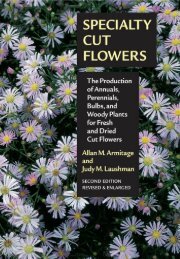You also want an ePaper? Increase the reach of your titles
YUMPU automatically turns print PDFs into web optimized ePapers that Google loves.
3.58<br />
80<br />
3.56<br />
3.56 TS of tbe secondary xylem of the<br />
dicotyledon Ulmus americana (American elm).<br />
This is a ring porous wood and clearly shows the<br />
abrupt transition between the smaller vessels (I l<br />
of the previous year's later growth and the large<br />
vessels (2) formed at the beginning of the new<br />
season. Ray parenchyma (3), fibres (4). (LM x<br />
75.)<br />
1 Smaller last season's vess.els<br />
2 Larger new 5CQl;Qn's vessels<br />
3 Ray parenchyma<br />
4 Fibres<br />
2<br />
3.57 TLS of the secondary xylem of the<br />
dicotyledon Ochroma lagopus (balsa). The<br />
abundant and large parenchymatous rays (Il. the<br />
thin·walled fibres (2), and the relatively few and<br />
thin-walled vessels (3) make this wood very light<br />
(specific gravity 0.1-0.16). Perforation plate (4),<br />
alternately arranged pits in vessel IS). (LM x 75.)<br />
1 P.arc:ncbymatous rays<br />
2 Thin-w.alled fibres<br />
3 Thin-walled vessels<br />
4 Perforation plate<br />
SPits<br />
3.57<br />
3.58 TLS of the coniIer wood of Pinus<br />
(pine). Note that the bordered pit> (1) occur<br />
in the radial walls of the tracheids bur arc:<br />
absenl from lhe ungential walls (2). The<br />
numerous non-storied rays (3) afe only a<br />
single cell wide but extend a number of cells<br />
in height (ef., 3.48). (LM x 110.)<br />
1 Bordered pits in radial walls<br />
2 Tangential walls (no pits)<br />
3 Non-storied rays





